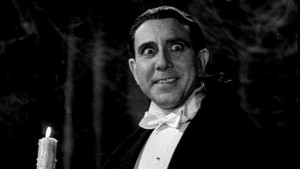
In time for Halloween, let’s dig into some creepy films that make use of the world’s second most popular language.
Until recently, when pouting and glittering in the sun became the familiar visual for vampirism, most were familiar with the caped and widow-peaked Bela Lugosi as Dracula. What most may not be familiar with is a similarly caped and widow-peaked Carlos Villarías in the same role.
As the film industry transitioned away from silent film and into talkies, they were faced with a problem: they could no longer simply swap out the intertitle cards that contained the film’s dialogue for dialogue in another language. Dubbing and subtitles had yet to be embraced, so they resorted to another option: Filming an entirely separate movie with the same sets with the same equipment as the English-language version. Native speakers were swapped out for the English-speaking Hollywood actors and their scenes were filmed during the downtime of the English-language production.
What is interesting about the Spanish-language version of Dracula, however, is that the Spanish-language crew was able to see the work of the English-language production and decided to try and top what they were doing, resulting in a more compelling and artistic picture:
“The American compositions are remarkably flat, like a plan performed on a narrow stage apron. [Spanish-language cinematographer George] Robinson’s camera work is distinguished by its use of multiple planes of focus and action. Foreground objects create tension and depth, while middle-ground devices (cobwebs, windows, branches, bars, etc.) further split and define the visual field.”
– David J. Skal, “The Spanish Dracula”, American Film, September 1990
Fast-forward 80 years. In the 21st century, things are actually going the other way: Spanish filmmakers are producing films in English as a way to expand their audience to a global level. A good example of this trend is the 2001 haunted-house-with-a-twist flick, The Others. Despite being set in British Jersey, the movie was shot by director Alejandro Amenábar (Abre los ojos) in Madrid and the Cantabria region of Spain.
With nary a lick of Spanish spoken, it was a gamble for a Spanish production, but The Others proved to be highly successful. It won 8 Goya Awards (Spanish Oscars), including Best Film–the first English-language film to do so. Internationally, it collected $209 million at the box office. Not too shabby. (Casting Nicole Kidman as the leading lady didn’t hurt, either.)
Another creepy English-language Spanish production that pulled the same trick is the Christian-Bale-as-mental-anorexic flick, The Machinist. This time, a Spanish production company and an American director used the outskirts of Barcelona to double for an anonymous American west coast city. Whoda thunk?
Some other Spanish-language chillers include:
The Orphanage
Pan’s Labyrinth
REC
The Blood Spattered Bride
Tesis
The Devil’s Backbone
Good books on Spanish-language cinema in general:
Blood Cinema
100 Years of Spanish Cinema
The Faber Book of Mexican Cinema
Research tools to find our more about scary Spanish films:
Film & Media Studies Research Guide

Ummm- won’t the ‘world’s second most popular language’ neccessarily be some variety of Chinese?
Actually Mandarin is ranked by Nationalencyklopedin as the world’s most popular language.
I highly recommend Pan’s Labyrinth to those who are comfortable with non-Hollywood-esque productions. It’s beautifully done, with a kind of mythic quality.